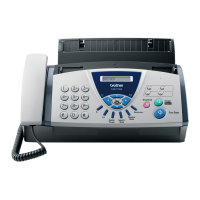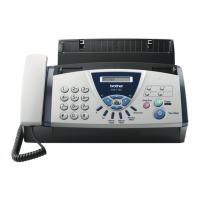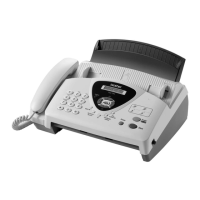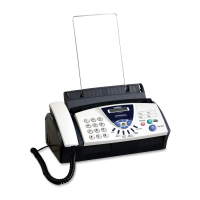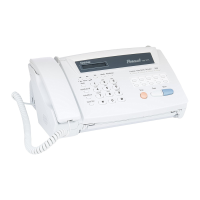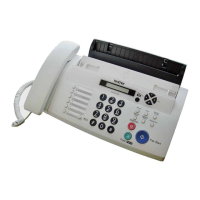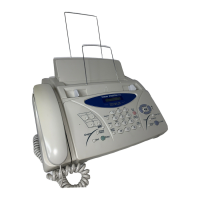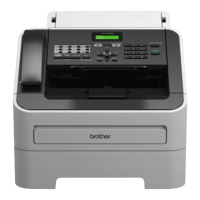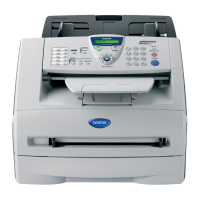
Do you have a question about the Brother FAX-T106 Series and is the answer not in the manual?
| Paper Capacity | Up to 100 sheets |
|---|---|
| Automatic Document Feeder (ADF) | 10 sheets |
| Memory Transmission | Yes |
| Out-of-Paper Reception | Yes |
| Print Technology | Thermal Transfer |
| Caller ID | Yes |
| Distinctive Ring Detection | Yes |
| Type | Plain Paper Fax |
| Compatibility | G3 |
| Resolution | 203 x 98 dpi |
| Paper Size | A4, Letter |
| Telephone Jacks | 1 |
| Speed Dial | 20 locations |
Notice regarding the compilation and publication of the user manual.
Essential safety instructions and warnings for proper and safe operation of the fax machine.
Instructions for sending faxes, including automatic and manual transmission methods.
Guidance on selecting receive modes and managing incoming fax operations.
Steps for storing One-Touch and Speed-Dial numbers for quick access.
Details on various dialling methods like One-Touch, Speed-Dial, and manual dialling.
Identification and description of the main components of the fax machine.
Explanation of the buttons and display on the FAX-T104 and FAX-T106 control panels.
General information about fax machines, custom features, and potential phone line conflicts.
Explanation of fax calling tones (CNG) and the handshake process during transmission.
Instructions for connecting external telephones and answering devices (TAD).
Guidelines for handling, storing, and specifications for using paper in the fax machine.
Overview of the fax machine's on-screen programming capabilities using LCD and navigation keys.
Explanation of how to use the navigation keys (Menu/Set, arrow keys) for menu operations.
A table detailing main menu selections, options, descriptions, and corresponding page numbers.
Initial steps for setting the date, time, and automatic daylight savings time.
Instructions for setting your name and fax number to appear on outgoing faxes.
How to adjust beeper, speaker, and ring volumes for different operational sounds.
Configuring the phone line type (PABX, ISDN) and dialling mode (Tone/Pulse).
Options for setting ring patterns and music on hold for the FAX-T106 model.
Guide to choosing receive modes (FAX ONLY, FAX/TEL, TAD) and setting ring delay.
Covers operations from extension phones, remote call transfer, and fax detection.
Step-by-step instructions for automatic, manual, and end-of-conversation fax sending.
Covers basic operations, contrast, resolution, cover pages, and other sending configurations.
Explores broadcasting, delayed fax, polling, TX lock, and other advanced sending functions.
Instructions for saving One-Touch, Speed-Dial, and Group numbers for easy dialling.
Explanation of manual dialling, search, redial, pause, mute, and tone/pulse dialling.
Setting up the fax machine to forward received faxes to another number.
Storing received faxes in memory for later retrieval using remote commands.
Procedure for setting a personal code to access remote retrieval features.
Instructions on how to call the fax machine remotely to retrieve messages.
List of commands used for managing fax forwarding, storage, and receiving modes remotely.
Steps to configure Message Manager, including voice store, OGM recording, and activation.
Covers playing, erasing messages, toll saver settings, and remote retrieval of voice/fax messages.
Information on printing transmission verification reports and fax journals.
Options for setting the transmission report to print for every fax or only on errors.
Configuration for the frequency of printing fax journals (e.g., every 30 faxes or hours).
Guide on how to print various reports like XMIT VERIFY, HELP LIST, and FAX JOURNAL.
Instructions on how to use the fax machine to make single or multiple copies.
Details on selecting copy options like number of copies, sort/stack, and reduce/enlarge ratios.
Critical safety guidelines for operating the fax machine safely and preventing hazards.
Information on registered trademarks related to the Brother brand and product.
Recommendations for packaging and shipping the fax machine safely to avoid damage.
Guides for resolving common error messages, compatibility issues, and operational difficulties.
Procedures for cleaning the print head and scanner, and changing the ribbon.
